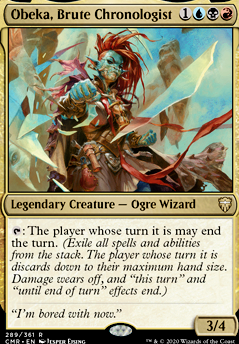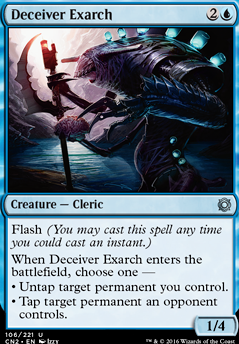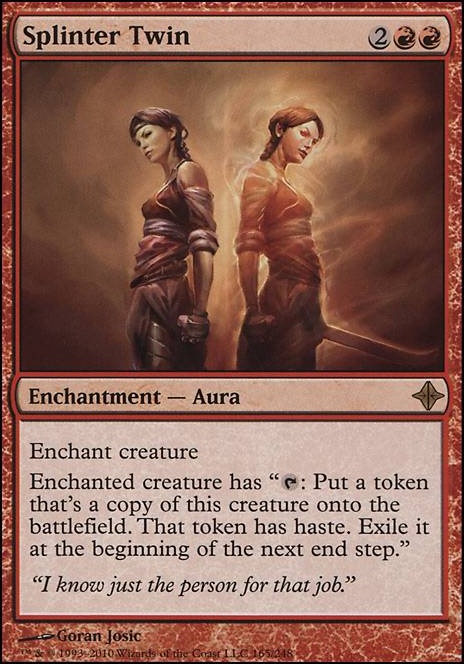Generates infinite hasty copies of Deceiver Exarch; enchant the Exarch with the Splinter Twin, tap it to make a copy and untap the original with the copy's enter-the-battlefield ability, then repeat.
Latest Decks

Discussion
Hipparchos on
 [Primer] Riku Pod
[Primer] Riku Pod
6 years ago
Have you ever thought about adding Deceiver Exarch + Splinter Twin to ditch Elesh Norn, Grand Cenobite?
lithium142 on [Community Discussion]: What makes a …
7 years ago
clayperce haha, nice! I was going to quote that same article =D
I think that's exactly where this discussion should start. That article focuses almost exclusively on a limited "draft" environment, but I feel you can take its lessons and apply them just as well to a standard environment.
combo decks really cant exist in limited, but if you are playing a combo deck, your combo also needs to be a constant thought. I.E. does this card help me hit my combo quicker, or make it more resilient. otherwise, can this act as an alternate win condition? with that in mind, if you are piecing together a combo, you need to put your pieces through these quadrants as though you were playing them alone. Any combo deck is better if their pieces dont suck on their own.
A great example of a combo deck that functioned with these quadrants in mind was Deceiver Exarch + Splinter Twin in modern. The enchantment had value in three quadrants because of the creatures in the deck. other than the winning combo, it hit hard on a Snapcaster Mage, Sun Titan, Restoration Angel. it hit there because these three creatures also had the potential for that kind of impact. it would hit on only the parity side if you played it on something like Vendilion Clique or Wall of Omens. still pretty good.
now away from combo decks. I think it's important to also consider the meta state of the format you're playing as well. This kind of falls under parity already, but i think that's a bit oversimplified for complex formats. I think format warping cards are the perfect way to discuss this, because you get to the heart of how it was warped, and what cards came up from it. That said, lets talk about Siege Rhino, or rather, the cards that came into the format solely because he was there. the way to do this is to consider popular cards at the time, and consider them at face value, and then re-look at them assuming you're staring down a rhino on the board.
the first card that comes to my mind is Roast. at face value, this will remove a creature, and nothing else. so it's ok on parity and misses the other 3. compare this with more versatile cards like Lightning Strike that hit both parity and victory and you question why you'd ever run this one. now what if a siege rhino is on the board? suddenly this card also hits losing.
can you think of some more cards that came into the format because of siege rhino? I'd love to see what you guys can think of for sake of discussion.
TMBRLZ on
 KIKLASCHULC (Hulk Flash :)
KIKLASCHULC (Hulk Flash :)
7 years ago
Why is this any better than Deceiver Exarch + Splinter Twin or Deceiver Exarch + Kiki-Jiki, Mirror Breaker or Kiki-Jiki, Mirror Breaker + Restoration Angel or any of the modern combos?
They don't make it any harder for you to kill more than one person. They require significantly less cards and significantly easier to achieve.
I'm just wondering why? I'm not saying it's a bad idea. I just question the mass amount of effort.
AndWelcomeToTheJam on The Tens of EDH 5: …
8 years ago
I will always remember the time where I vanilla-cast the Deceiver Exarch + Splinter Twin combo on Turn 4. After one opponent saw me reveal the Exarch a turn earlier he said and I quote, "You don't have the Splinter Twin." Let's just say there are never enough boardwipes at my playtable.
buildingadeck on
 Jori En, Combo Diver
Jori En, Combo Diver
8 years ago
Madneko: Thanks for the +1. The combos that win the game for me are pretty vast.
To win the game outright:
Deceiver Exarch + Splinter Twin
Kiki-Jiki, Mirror Breaker + Pestermite
Deceiver Exarch + Kiki-Jiki, Mirror Breaker
Kiki-Jiki, Mirror Breaker + Zealous Conscripts
Kiki-Jiki, Mirror-Breaker + non-legendary creature + Intruder Alarm
Cloud of Faeries + Deadeye Navigator + Impact Tremors or Purphoros, God of the Forge
Deadeye Navigator + Great Whale + Impact Tremors or Purphoros, God of the Forge
Deadeye Navigator + Impact Tremors + Peregrine Drake or Purphoros, God of the Forge
Storm is in there for the infinite mana combo with Capsize in hand, but I could back running the Mind's Desire in place of the Ignite Memories.
Mackman99 on [Community Discussion]: Modern Chat
8 years ago
Wouldn't Auriok Champion's ability to gain life whenever a creature enters the battlefield make it good against the Deceiver Exarch + Splinter Twin combo, as the Deceiver Exarchs can only deal one damage each?
rorofat on Need verification for this combo
8 years ago
Yeah, it could work, but just going for Deceiver Exarch + Splinter Twin is still in your colors and requires less cards...
JA14732 on I just want a simple …
8 years ago
Okay, so I'll just give a quick primer on deck-building.
Keep the classic RPS model in mind:
Aggro < Combo < Control < AggroOrAggro < Midrange < Control < Aggro
Every deck with a plan fits into one of these 4 major archetypes (technically, there are 6+ but most play as variations of these 4), each of whom have a distinct goal.
Aggro, derived from the word "aggression," seeks to beat its opponents as quickly as is possible, often playing smaller, cheaper and more mana - efficient creatures and spells (Monastery Swiftspear, Goblin Guide, Zurgo Bellstriker, etc). Examples include Burn, Sligh and Affinity. These decks are strong early but the moment they run out of gas it's over. Red is usually preferred in these decks but isn't required.
Combo is an interesting archetype, seeking to assemble their combo in order to win instead of win in more "fair" ways. Examples of these combos include Deceiver Exarch + Splinter Twin , Exquisite Blood + Sanguine Bond and Hive Mind + Pact of Negation . These decks often can win completely out of nowhere, and have no cares about life total. There is no specific color identity in combo, but blue can be highly prevalent due to its draw power.
Control is the slow guy. Control decks seek to outdraw/outremove their opponents and use their sheer late game power to win. Popular cards in the past include Counterspell, Sphinx's Revelation, Damnation and Jace, the Mind Sculptor. By keeping your opponents down or healing off their attempts on your life, you win late. Blue is extremely popular in control decks, bringing draw power and counterspells to the table.
Midrange is the last major archetype. Its idea is to, after turn 3 or 4, always drop a strong threat on the board each turn. Popular cards in midrange include Tarmogoyf, Siege Rhino and Thragtusk. By keeping up on these threats, midrange decks force their opponents to spend cards to halt their board presence. Green is somewhat popular in midrange decks, supplying a good number of potent threats.
You also mentioned mill. I'm not going to go in depth, but mill is a "burn" deck that attacks the opponent's library instead of life total. It's kind of a weird aggro-control hybrid, but weak.
The best resource for learning more about the game is through practice, but Mark Rosewater's Making Magic column on the MTG Archives has some golden articles (you'll have to do some digging, I'm on a phone rn). Also mtgsalvation helped me a good deal early.
Good luck!





